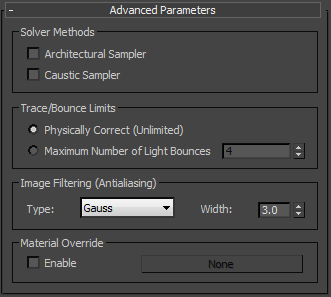The Advanced Parameters rollout contains more specific controls for the iray renderer.
Interface

Solver Methods group
- Architectural Sampler
- Turn on for interior scenes. Architectural sampling improves the accuracy of interior lighting, and reduces the graininess of the rendering. Important: While the Architectural Sampler is active, iray renders only motion blur that results from camera motion. All other kinds of motion blur are ignored.
- Caustic Sampler
- Turn on for scenes that include caustics. Caustics are light patterns that occur when light illuminates a surface via specular reflection or transmission; for example, the light cast onto a tablecloth by a glass of water. Caustics sampling improves the accuracy of these patterns.
Trace/Bounce Limits group
- Physically Correct (Unlimited) (The default.) When chosen, light bounces are unlimited, and are calculated as long as the renderer continues to run.
- Maximum Number of Light Bounces When chosen, limits the number of light bounces to the value you set. Default=4.
Limiting the number of light bounces can speed up a rendering. This option can be helpful when you want to render a preview that doesn’t have to have full and finished reflections.
If you limit the number of light bounces, scenes can appear darker than the final rendering with unlimited bounces would appear. This is true especially for interior scenes, and exterior scenes that are lit from all around (typically by the sky).
Image Filtering (Antialiasing) group
Determines how multiple samples are combined into a single pixel value.
- Type
-
- Box Sums all samples in the filter area with equal weight. This is the quickest sampling method.
- Gauss (The default.) Weights the samples using a Gauss (bell) curve centered on the pixel.
- Triangle Weights the samples using a pyramid centered on the pixel.
- Width
- Specifies the width and height of the sample area. Increasing the value of Width can soften the image, but it increases render time. Default=3.0.
Material Override group
Material Override allows you to render a scene with all its materials replaced by a single master material. For example, if you want to do a shadow study using volume only, with a single uniform color, use these controls to specify a neutral gray material. When you render, all surfaces will use the gray material.
- Enable
- When on, rendering uses the override material for all surfaces. When off, surfaces are rendered with the material applied to them in the scene. Default=off.
- [material button]
- Click to display the Material/Map Browser and choose a material to use as the override. Once you have chosen an override material, this button displays the material name.